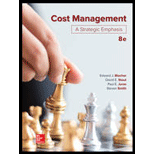
1. a
Calculate the direct labor efficiency variance and state whether it is favorable (F) or unfavorable (U).
1. a
Explanation of Solution
Calculate the direct labor efficiency variance and state whether it is favorable (F) or unfavorable (U).
1. b
Calculate the direct labor rate variance and state whether it is favorable (F) or unfavorable (U).
1. b
Explanation of Solution
Calculate the direct labor rate variance and state whether it is favorable (F) or unfavorable (U).
1. c
Calculate the actual number of kilograms of material used in the production process during the month.
1. c
Explanation of Solution
Calculate the actual number of kilograms of material used in the production process during the month.
1. d
Calculate the actual price paid per kilogram of material during the month.
1. d
Explanation of Solution
Calculate the actual price paid per kilogram of material during the month.
Note: price variance is calculated at the point of purchase.
Working note:
(1)Calculate the direct materials purchase-price variance:
1. e
Calculate the amount of direct materials cost and direct labor cost transferred to the finished goods inventory account during the end of the month.
1. e
Explanation of Solution
Calculate the amount of direct materials cost and direct labor cost transferred to the finished goods inventory account during the end of the month.
1. f
Calculate the total amount of direct materials cost and direct labor cost in the work-in-process inventory account during the end of the month.
1. f
Explanation of Solution
Calculate the total amount of direct materials cost and direct labor cost in the work-in-process inventory account during the end of the month.
| Materials | Labor | Total | |
| Equivalent units in ending WIP inventory | 800 | 600 | |
| × $40 | × $109.20 | ||
| Ending inventory at standard cost | $32,000.00 | $65,250 | $97,520 |
Table (1)
2.
Prepare
2.
Explanation of Solution
Prepare journal entries to record all transaction.
| Date | Account Title and Explanation | Debit ($) | Credit ($) |
| Direct materials Inventory | $250,000 | ||
| Direct materials Purchase-price Variance | $750 | ||
| Accounts Payable (plug) | $249,250 | ||
| [Purchase of 50,000 kilograms of materials for $249,250 ($4.985 per kg.)] |
Table (2)
| Date | Account Title and Explanation | Debit ($) | Credit ($) |
| Work-in-process inventory | $256,000 | ||
| Direct materials usage variance (plug) | $1,500 | ||
| Direct materials inventory | $257,500 | ||
| (Issued 51,500 kilograms of material to produce 6,400 equivalent units) |
Table (3)
| Date | Account Title and Explanation | Debit ($) | Credit ($) |
| Work-in-process inventory | $677,040 | ||
| Direct labor rate variance | $64,300 | ||
| Direct labor efficiency variance | $12,740 | ||
| Accrued payroll | $600,000 | ||
| (To record direct labor wages and standard direct labor cost incurred to manufacture 6,200 equivalent units) |
Table (3)
Want to see more full solutions like this?
Chapter 14 Solutions
Loose Leaf for Cost Management: A Strategic Emphasis
- I am searching for the correct answer to this general accounting problem with proper accounting rules.arrow_forwardPlease explain the solution to this financial accounting problem with accurate principles.arrow_forwardKodak Inc. sells its product for $95 per unit. During 2023, it produced 85,000 units and sold 68,000 units (there was no beginning inventory). Costs per unit are: direct materials $22, direct labor $19, and variable overhead $6. Fixed costs are: $1,275,000 manufacturing overhead, and $127,000 selling and administrative expenses. The per-unit manufacturing cost under absorption costing is__. Helparrow_forward
- Your boss asks you to compute the company's cash conversion cycle. Looking at the financial statements, you see that the average inventory for the year was $157,800, accounts receivable were $128,500, and accounts payable were at $143,600. You also see that the company had sales of $412,000 and that cost of goods sold was $346,000. What is your firm's cash conversion cycle? Round to the nearest day.arrow_forwardI am trying to find the accurate solution to this financial accounting problem with the correct explanation.arrow_forwardI need help with this financial accounting question using the proper financial approach.arrow_forward

 AccountingAccountingISBN:9781337272094Author:WARREN, Carl S., Reeve, James M., Duchac, Jonathan E.Publisher:Cengage Learning,
AccountingAccountingISBN:9781337272094Author:WARREN, Carl S., Reeve, James M., Duchac, Jonathan E.Publisher:Cengage Learning, Accounting Information SystemsAccountingISBN:9781337619202Author:Hall, James A.Publisher:Cengage Learning,
Accounting Information SystemsAccountingISBN:9781337619202Author:Hall, James A.Publisher:Cengage Learning, Horngren's Cost Accounting: A Managerial Emphasis...AccountingISBN:9780134475585Author:Srikant M. Datar, Madhav V. RajanPublisher:PEARSON
Horngren's Cost Accounting: A Managerial Emphasis...AccountingISBN:9780134475585Author:Srikant M. Datar, Madhav V. RajanPublisher:PEARSON Intermediate AccountingAccountingISBN:9781259722660Author:J. David Spiceland, Mark W. Nelson, Wayne M ThomasPublisher:McGraw-Hill Education
Intermediate AccountingAccountingISBN:9781259722660Author:J. David Spiceland, Mark W. Nelson, Wayne M ThomasPublisher:McGraw-Hill Education Financial and Managerial AccountingAccountingISBN:9781259726705Author:John J Wild, Ken W. Shaw, Barbara Chiappetta Fundamental Accounting PrinciplesPublisher:McGraw-Hill Education
Financial and Managerial AccountingAccountingISBN:9781259726705Author:John J Wild, Ken W. Shaw, Barbara Chiappetta Fundamental Accounting PrinciplesPublisher:McGraw-Hill Education





